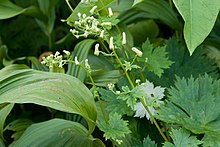기악토닌
Gigactonine | |
| 이름 | |
|---|---|
| IUPAC 이름 (1α,6β,14α,16β)-20-에틸-4-(히드록시메틸)-6,14,16-트리메톡시카니탄e-1,7,8-트리올 | |
| 식별자 | |
3D 모델(JSmol) | |
| 켐스파이더 | |
펍켐 CID | |
CompTox 대시보드 (EPA) | |
| |
| |
| 속성[1] | |
| C24H39NO7 | |
| 어금질량 | 453.576 g·190−1 |
| 녹는점 | 168°C(334°F, 441K) |
달리 명시된 경우를 제외하고, 표준 상태(25°C [77°F], 100 kPa)의 재료에 대한 데이터가 제공된다. | |
| Infobox 참조 자료 | |
Gigactonine은 자연적으로 발생하는 디테르펜 알칼로이드로 아코니툼 기가스에서 처음 격리된 것이다. 라눈쿨라과 식물과에 널리 분포한다. 이 화학 화합물의 다핵성 고리 시스템은 19개의 탄소 원자와 1개의 질소 원자를 포함하고 있는데, 이는 아코니틴과 동일하며, 이는 선호하는 IUPAC 이름에 반영된다.
역사
지악토닌은 1978년 아코니툼 기가스에서 격리된 후 보고되었다. 당시 참신한 구조였지만, 4-히드록시메틸 1차 알코올 사이드체인에 메틸화 된 델솔린을 포함한 알려진 디테르펜 알칼로이드와 관련이 있는 것으로 인식되었다.[1]
합성
비록 이 알칼로이드 등급의 개별 구성원들이 광범위하게 연구되었지만, 화학적 복잡성으로 인해 개별적으로 합성된 수가 제한되었다. 마찬가지로, 그들의 완전한 생합성 경로는 대부분의 경우에 개략적으로만 알려져 있다.[2]
자연발생
기갑토닌은 아코니툼 리콕토늄[3] 꽃의 주 알칼로이드로 보고되어 있으며, 라눈쿨라과 식물과의 델피늄 아자시스[5], 기타 포로시다 종 등 델피늄과[4] 격리되어 있다.[6]
생화학
아코니틴과 관련된 화합물은 생물학적 시스템에서 그 성질을 위해 광범위하게 연구되고 있으며, 이러한 성분들은 검토되었다.[6] 예를 들어, 기가토닌은 hERG 억제 활동을 하는 것으로 보고되었다.[7]
참조
- ^ a b Sakai, S.; Shinma, N.; Hasegawa, S.; Okamoto, T. (1978). "On the Alkaloids of Aconitum gigas Lev. et Van. and the structure of a New Base, Gigactonine". Yakugaku Zasshi. 98 (10): 1376–1384. doi:10.1248/yakushi1947.98.10_1376.
- ^ Cherney, Emily C.; Baran, Phil S. (2011). "Terpenoid-Alkaloids: Their Biosynthetic Twist of Fate and Total Synthesis". Israel Journal of Chemistry. 51 (3–4): 391–405. doi:10.1002/ijch.201100005. PMC 4508874. PMID 26207071.
- ^ Chen, Ying; Katz, Alfred (1999). "Isolation of Norditerpenoid Alkaloids from Flowers of Aconitum lycoctonum". Journal of Natural Products. 62 (5): 798–799. doi:10.1021/np980576q. PMID 10346976.
- ^ Yin, Tianpeng; Cai, Le; Ding, Zhongtao (2020). "An overview of the chemical constituents from the genus Delphinium reported in the last four decades". RSC Advances. 10 (23): 13669–13686. doi:10.1039/D0RA00813C.
- ^ Pelletier, S. William; Bhandaru, Sudhakar; Desai, Haridutt K.; Ross, Samir A.; Sayed, Hanna M. (1992). "Two New Norditerpenoid Alkaloids from the Roots of Delphinium ajacis". Journal of Natural Products. 55 (6): 736–743. doi:10.1021/np50084a005.
- ^ a b Yin, Tianpeng; Cai, Le; Ding, Zhongtao (2020). "A systematic review on the chemical constituents of the genus Consolida (Ranunculaceae) and their biological activities". RSC Advances. 10 (58): 35072–35089. doi:10.1039/D0RA06811J.
- ^ "Diterpene alkaloids from Aconitum anthora and assessment of the hERG-inhibiting ability of Aconitum alkaloids" (PDF). Planta Med. 77: 368–73. 2011. doi:10.1055/s-0030-1250362. PMID 20862641.



